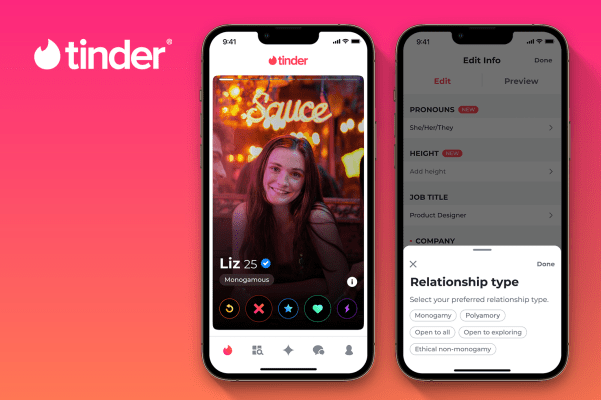Tinder today is rolling out more features aimed at helping people find the right relationships for them, while also being more authentic on their dating profiles. Borrowing a feature from Hinge, another app owned by Tinder parent Match Group, Tinder users will now be able to indicate on their profiles the type of relationship they’re looking for — which today may involve various concepts around non-monogamy. It will also now allow members to display their pronouns on their profile.
Tinder and Hinge are starting to look more and more like the same app as Match sets its sights on attracting Gen Z users to fuel its growth. Though each app is marketed to slightly different segments of the online dating market, their feature sets are starting to line up. We saw this earlier with December’s launch of Tinder’s Relationship Goals feature — a feature it borrowed from Hinge — which lets people clarify what they’re looking for in terms of long or short-term commitment.
Now Tinder is stealing another Hinge feature with the addition of Relationship Types, which Hinge had introduced in November.
With Tinder’s update, members will be able to choose from a variety of terms they prefer to describe their desired relationship type, like monogamy, ethical non-monogamy, open relationship, polyamory or even “open to exploring.” Tinder says it’s making this shift as it found that 41% of Gen Z users are either open to or are actively seeking non-monogamous relationships.
According to a survey of 4,000 singles conducted on its behalf earlier this year, Tinder also found that open relationships (36%) and hierarchical polyamory (26%) were the most popular types of non-monogamous relationships among 18- to 25-year-old actively dating singles in the U.S., U.K., Australia and Canada.
Of course, consumer interest may not be the only thing driving Tinder to adopt the feature.
Its lack of more direct support for non-monogamous relationships in its product has frustrated both those seeking non-monogamy and those looking to avoid it. That’s led to a growing number of niche dating apps dedicated to non-monogamy, like Feeld, #Open, MoreThanOne and PolyFinda, as no one enjoyed being matched with someone whose relationship ideas and goals are so completely different from their own.
The addition of the feature also aligns with Tinder’s newly added Relationship Goals, which center on what people are looking for from a relationship outside of the “type.” This addition has allowed users to specify if they are in search of a “life partner,” or a “long-term,” “long-term, open to short-term,” “short-term, open to long-term” or “short-term” relationship. Users can also say they are just “figuring out my dating goals,” if they don’t know.
Another new feature will now allow Tinder members to display up to four pronouns on their profile from a list of over 15 options, in addition to their sexual orientation and gender — which has been available for years. Again, Tinder cites Gen Z survey data as driving this change, noting that among singles ages 18-25, 33% agreed that their sexuality is more fluid, and 29% said their gender identity has become more fluid in the past three years. The company also said the LGBTQIA+ community is the fastest-growing group on Tinder.
Combined, the new features could help deliver better outcomes for Tinder members, as they could more easily vet potential matches and express themselves on the app. But the features serve another purpose as well: to lure Gen Z users back to Tinder.
As Financial Times reported last year, Tinder had been struggling to attract new users after the lift of COVID lockdowns. The report noted that downloads of the app had dropped 5% in 2021, even as rivals grew, signaling user interest in exploring alternatives. More recently, Match Group forecast first-quarter 2023 revenue below expectations after Tinder drove the company’s first-ever quarterly revenue decline.
To address the Gen Z problem, Tinder recently unveiled a new marketing campaign, “It Starts with a Swipe.” The new ads aim to speak directly to this younger demographic, who often think of love and romance differently than older generations. Inspired by Gen Z, the campaign “not only celebrates a diversity of possibilities, but also genders, orientations, and multiculturalism,” the company said.
The new features are rolling out now to Tinder’s mobile app.
Relationship Type will be available in the U.S., Canada, Australia, the U.K., Brazil, France, The Netherlands, Indonesia, Taiwan, Italy, Spain, Thailand, Sweden, Germany and Mexico. However, the pronouns feature is U.S.-only at this time, Tinder notes.
